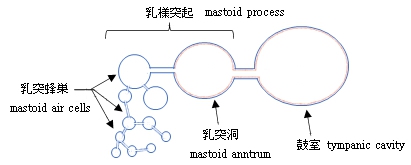
【主な特徴】 ※参考:「ウィキペディア」
・乳突蜂巣と同様含気しているが、鼓室と交通していて、鼓室にある粘膜がここまで延びている。
・上方は、板状の薄い骨である鼓室蓋によって中頭蓋窩と隔てられている。
・下方では乳様突起と、外側では側頭線直下で側頭骨鱗部と、内側では鼓室洞に飛び出した内耳の
外側半規管腔と接している。
・前方で鼓室の一部(上鼓室または鼓室の上陥凹という部位)に開口している。
・出生時にはかなり大きな空洞である。


以下は「Wikipedia」の解説文となる。
The mastoid antrum (tympanic antrum, antrum mastoideum, Valsalva's antrum) is an air space in the petrous portion of the temporal bone, communicating posteriorly with the mastoid cells and anteriorly with the epitympanic recess of the middle ear via the aditus to mastoid antrum (entrance to the mastoid antrum). These air spaces function as sound receptors, provide voice resonance, act as acoustic insulation and dissipation, provide protection from physical damage and reduce the mass of the cranium.
The roof is formed by the tegmen antri which is a continuation of the tegmen tympani and separates it from the middle cranial fossa. The lateral wall of the antrum is formed by a plate of bone which is an average of 1.5 cm in adults. The mastoid air cell system is a major contributor to middle ear inflammatory diseases.
【 語 句 】
・petrous portion:岩様部 ・temporal bone:側頭骨 ・mastoid cells:乳突蜂巣 ・epitympanic recess:鼓室上陥凹 ・middle ear:中耳 ・aditus to mastoid antrum:乳突洞口 ・receptor:受容体 ・resonance:共鳴 ・acoustic insulation:防音 ・dissipation:消失 ・tegmen antri :? ・tegmen tympani:鼓室蓋 ・middle cranial fossa:中頭蓋窩 ・inflammatory diseases:炎症性疾患
■ 写真やイラストを掲載しているサイト ■
・ イラストや写真を掲載しているサイト-Ⅰ
・ イラストや写真を掲載しているサイト-Ⅱ
・ イラストや写真を掲載しているサイト-Ⅲ
